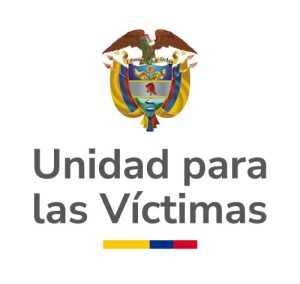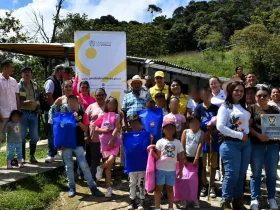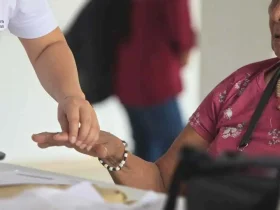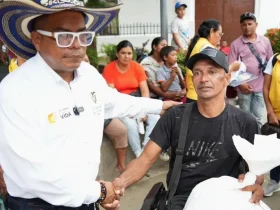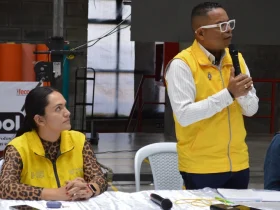By Daisy Tibidor
Amid poetry recitals, songs, verse improvisations and typical “Llanero” folklore expressions, which honored the experiences of the Casanare people and motivated smiles, stood out faces that expressed certain strength, among those was Nohemi Sanabria’s face, who wore a “conuquero” hat, as well as a Colombian flag face paint with a tear on her cheek. With satisfaction, she was displaying a canvas painting she named: “The victims’ soul”, which alluded to the Memory and Solidarity with the Victims National Day.
It was April 9th in the Plazuela of the Alcaravan shopping center in Yopal, and Nohemi attended in order to, through her art, give a voice to the more than 74,000 victims in the Casanare department that appear in the Single Victims Registry (RUV in its Spanish acronym).
This work was done using techniques detailed in free painting, sculpture, and relief painting, and that is why “The Soul of the Victims” conveyed chaos and hope simultaneously.
In the middle of said work, the silhouette of a woman stands out with a tear on her cheek, the same one that Nohemi had painted on her face. An image that reflects women in the conflict and their resilience.
Brave Heart
Behind Nohemi’s big smile and enthusiastic voice, dark memories of the conflict were hidden, led by self-defense groups and guerrillas, which left only sadness and pain more than 20 years ago. Among those past images, Nohemi doesn’t forget the circumstances that came from the conflict when she lost her father, a “llanero” with a noble heart, of whom she keeps a photo that highlights the traits of a man who was an example of the “llanero.”
On that fateful day, she had to walk for hours into the fields searching her father, driven by rumors that something had happened to him. Already tired, but without losing hope, in the distance she spotted his loyal white horse, and when she got closer, she found his lifeless body.
She heard the rumor the night before. “I looked for a rope, formaldehyde and sheets to get up early and go through bridle paths, forests and stones, which didn’t prevent me from bringing him on the back of the horse only Marcos Sanabria rode.”
Looking at the photo, the artist recalled that to find her father’s body, she was alone and didn’t have the help of the neighbors. She found out a few months later “the guerrillas were watching and all of them were afraid.”
But this wasn’t the only sadness she faced. With her two small children, she was displaced from her farm and almost lost one of them, who was part of the hundreds of children and young people used by the groups in the war.
For that reason, to prevent her other son from suffering the same fate, she had to leave him and her husband; they left town for safety. She decided to stay to look for answers and track down the whereabouts of her other son, who had been taken from her when he was just 12 years old.
Nohemi is one of the people who suffered from the victimizing acts of forced displacement (58,834), homicide (14,806) and minor recruitment (204) in Casanare. Tauramena municipality, for its part, has 5,038 conflict victims, of which 4,255 are due to displacement; 836 for homicide and 14 for minors forced recruitment.
As a result, she understood she had to make herself visible. That is why she ran for the municipal council. She was elected and served as the only woman. In this way, she was able to learn more about the ailments of displacement and forced disappearance.
For this reason, in 2004, she took the position of spokesperson along with 17 other Tauramena inhabitants, with the goal to reject abuses and help the families that, at that time, were displaced in the south of her municipality. Because of that initiative, a persecution was unleashed against
Her good deeds’ reward came three years later, when she was finally able to rescue her son, who was released after many pleas.
When that time of anguish was over, mother and son joined experiences to share the message among other young recruits and their families.
The art of service
Nohemi’s brave soul is still intact. That is why she never left her town; on the contrary, she chose to stay to leave the past behind and move on with her life.
In Tauramena she excels in her distinct roles: the mother, the artist, the social leader, the entrepreneur, and the dreamer. Her house is next to the village’s “coleo”[1] track, where she runs a restaurant well-known for its good service; she also exhibits her artistic work there.
People say the place looks like a small museum, because it is embedded with the native magic that is preserved in the harp, the cuatro and the maracas culture.
Her artistic sensibility is a gift that she discovered on her own and perfected over the years. Many of her pieces are bought by art lovers; others remain in her own home.
“What for others is firewood, for me it is a potential work of art for my home or the restaurant”, she affirms.
Now, her fight is for a concept of life and progress that allows the victims to leave that grim abyss the conflict plunged them to; a premise that has helped her achieve those goals that today make her a different person.
Nohemi is part of the Effective Victims Participation Board in Tauramena, an advocacy space where she knows she will be able to deliver her message of overcoming life to other victims, so that, like her, they persist and build a better future together.
(End/DMT/COG/EGG/RAM)
[1] Traditional Venezuelan and Colombian sport, very similar to a rodeo, where a small group of llaneros (cowboys) on horseback pursue cattle at high speeds through a narrow pathway (called a manga de coleo) in order to drop or tumble them.

